In my experience as a courtroom planning consultant, I’ve had the opportunity to plan for many types and styles of courtrooms. While there are many different issues regarding courtroom design – including sightlines, furniture options, and access requirements – the focus of this blog will be on the core element of the courtroom: the location of the judge's bench. Whether you are constructing a new courthouse or renovating within existing space, the location of the judge’s bench is one of the first things to consider when designing the courtroom. The placement of all other components within the courtroom depends on the placement of the judge’s bench. In the vast majority of cases, a center bench is ideal. But when space is limited or irregularly shaped, a corner bench may be the best option.
Center Bench
A judge’s bench that is centered in the courtroom well provides an anchor point for the courtroom, and creates balance. This is typically the best option for standard-sized, rectangular courtrooms. The most obvious benefit of a center bench is that it clearly places the judge at the center of the proceedings. Additionally, it allows for the judge’s bench to be directly opposite the attorney tables and spectator area. I have been told by numerous attorneys that this gives the sense of balanced and fair treatment for both prosecution and defense.
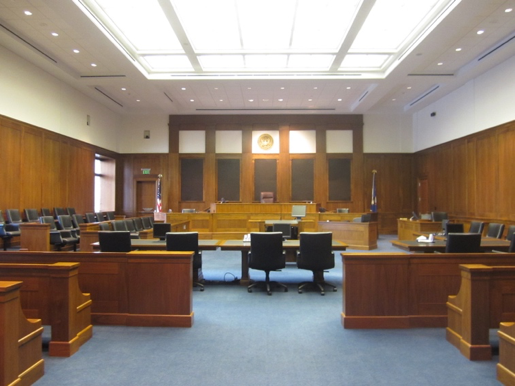
Center Bench
In a courtroom with a center bench, the other courtroom components are generally arranged in the following manner relative to the position of the judge’s bench:
- Witness Stand: immediately adjacent to the judge’s bench with clear sightlines to the jury and courtroom participants
- Jury Box: to the side of the judge’s bench near jury room access with clear sightlines to the judge and courtroom participants
- Spectator Area: adjacent to public access, opposite the judge’s bench
- Attorney Tables: in front of the judge’s bench with the defendant’s attorney table closest to prisoner entry point
- Court Reporter/Court Clerk/Bailiff Area: in front of or beside the judge's bench with a clear view of participants (this area can also include an interpreter)
The image below represents a typical center bench arrangement for an 1,800 sq.ft. courtroom.
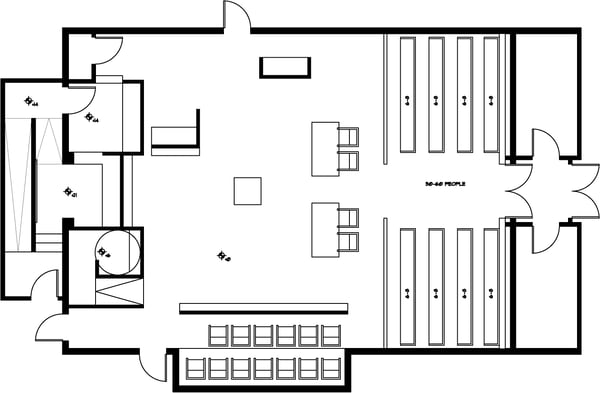
The features listed above are all present in the above courtroom providing symmetry and balance in the well area, which is where proceedings are conducted.
Corner Bench
In a smaller courtroom, or one that is uneven in its proportions, a corner bench may allow for more space in the well area than a traditional center bench would allow. The corner location is particularly useful when the space is either square or irregular in shape, or not very deep. The well area can be maximized by providing a corner judge’s bench. It still places the judge in a visible position, but allows the well area to be located toward the open space at the front of the room.
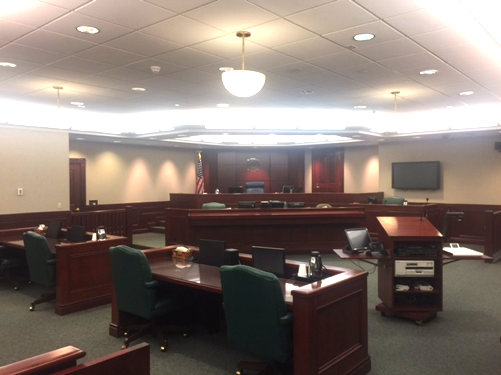
Corner Bench
The components of the courtroom must be carefully arranged when the judge’s bench is located in the corner. In the image below, a 1,600 SF courtroom with a corner bench was proposed for a renovation project where the column spacing was very narrow and did not allow for both a center bench and proper circulation in the well area. Using a corner bench arrangement enabled sufficient space for the furniture and parties in the well.
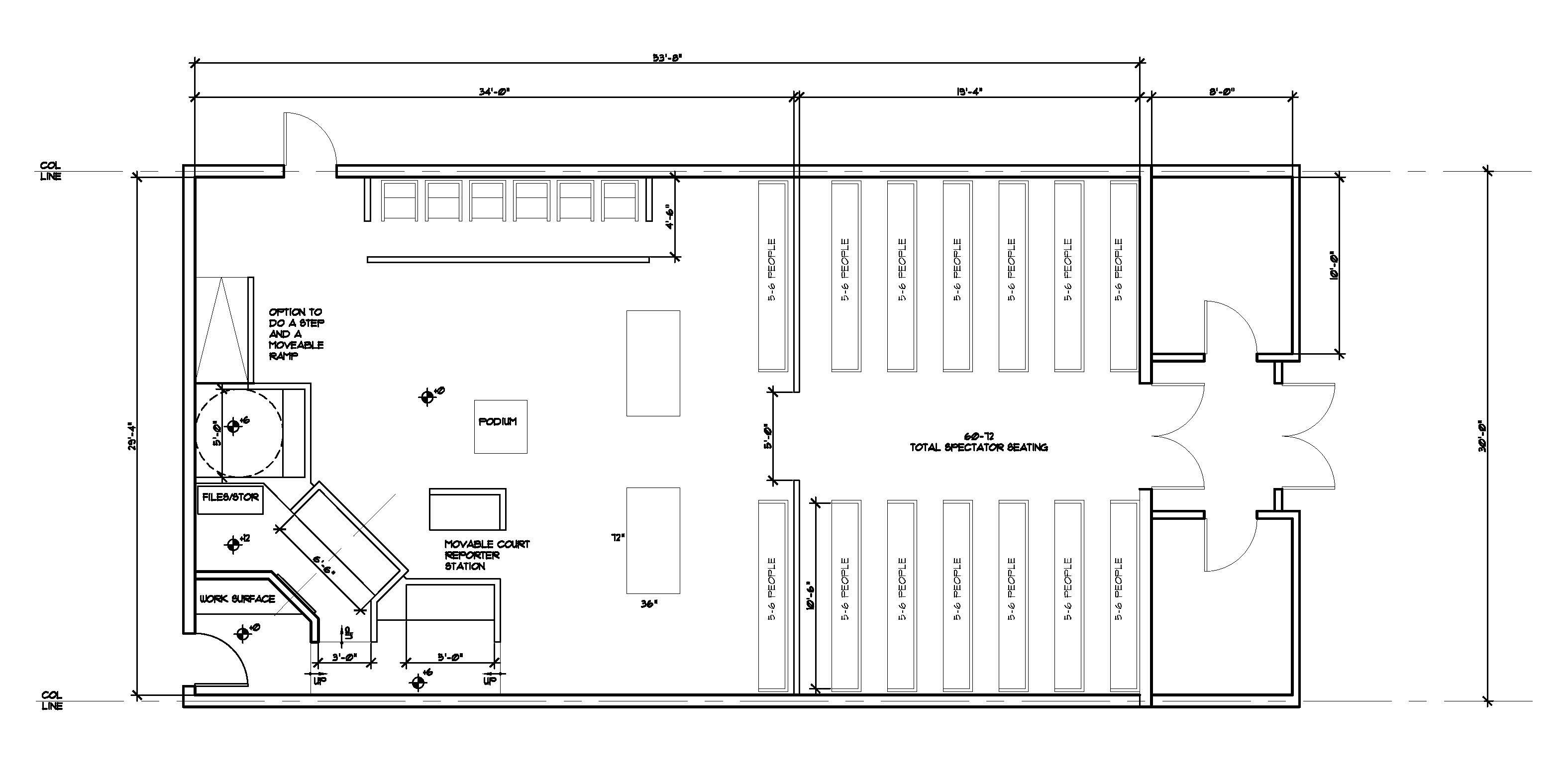
Here is a rendering of the above courtroom presenting the view from counsel tables to the judge's corner bench.
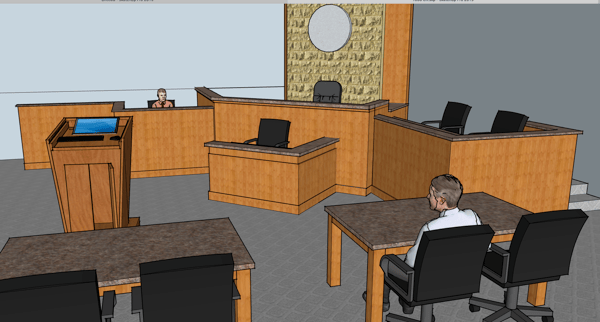
In another courthouse I worked in, the corner bench was used in a courtroom to maximize the well area and to take advantage of a nook in the corner of an otherwise small square space. The courtroom was arranged with a large spectator area, and the judge’s bench was to the left when looking towards the front of the room. The witness stand was almost directly in the center of the far wall (to the left of the judge’s bench), and the jury box was to the far right of the room. Although it was a bit unsettling that the witness box was centered within the room, even more unsettling was that the attorneys’ backs were sometimes completely turned to either the jury or the judge. I was also told that litigants felt that the jury was more apt to look favorably on the arguments presented by the attorneys sitting at the table closest to the judge. For both of these reasons, a corner bench might be more appropriately used for non-jury proceedings, such as arraignments or initial appearances.
The Center Bench Wins… In Most Cases
When it comes down to it, the location of the judge’s bench can best be determined by the dimensions of the courtroom. The default option for most standard-sized, rectangular courtrooms will most certainly continue to be the center bench arrangement. However, for non-jury proceedings or for smaller or irregular spaces, particularly in renovation projects, the corner bench may provide a more functional layout. The best approach is achieved when designers keep an open mind and place the bench in a location that allows the most functionality in the courtroom, and also preserves critical sightlines, adjacencies, and balance.
This blog was originally published in July 2015 and has been refreshed and updated with new information.
______________________________________________________________
To learn more about courtrooms, click on the image below for our Courtroom and Chambers guide.



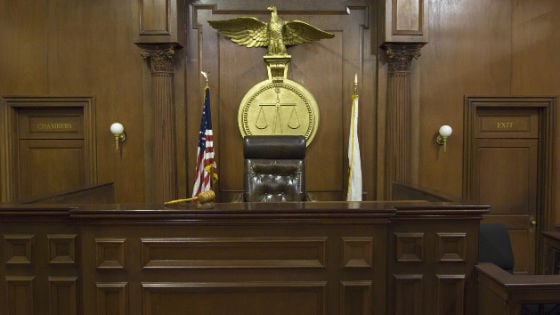
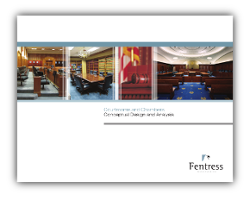
.jpg)
.jpg)
.jpg)
.jpg)
.jpg)
.jpg)


.jpg)
.jpg)
-1.jpg)
.jpg)
.jpg)
.jpg)
.jpg)
.jpg)

